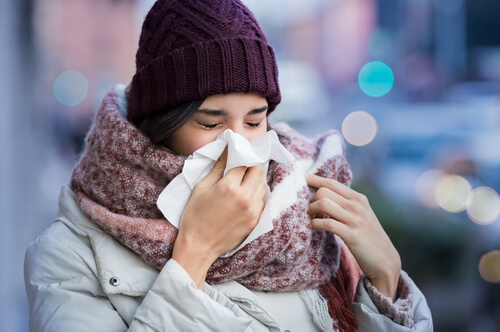Allergy or Hypersensitivity: Everything You Need to Know

Allergy, or hypersensitivity, is very common today and is one of the main chronic diseases that humans can suffer. The allergy is caused by an exaggerated response of the immune system to substances that, in general, are harmless.
Allergic patients, although it may not seem like it, don’t only suffer from a physical health problem. This pathology also has an important psychological impact, as it significantly decreases the quality of life.
Among the allergy symptoms, we can find headaches, sneezing, nasal obstruction, and watery eyes. This is why, on many occasions, we could confuse an allergic or hypersensitivity episode with a cold. Learn more in this article.
What is allergy or hypersensitivity?
Allergy or hypersensitivity is an exaggerated reaction of the immune system to external substances that for the rest of the people are harmless. These substances are called allergens.
Repeated exposure to the same allergen will produce allergy symptoms. In some cases, repeated exposure will add new manifestations, generally more severe. One of the most frequent allergic manifestations is a respiratory allergy, such as allergic rhinitis.
The most common allergens in respiratory allergy are:
- Pollen
- Dust mites
- Animal fur
- Mushrooms
- Medications
- Bee and wasp poison
- Allergy due to contact with certain substances. For example, contact eczema due to nickel allergy from earrings or metal watch straps.

How does the allergy occur?
The first step is contact with allergens, usually by inhalation or ingestion. This will generate a response from the immune system, which leads to the formation of antibodies called immunoglobulins. These react specifically against the allergen.
The antibodies reach the blood and bind to cells called mast cells. Mast cells are found in the skin and mucosa and contain substances responsible for the clinical symptoms of allergy. These pro-inflammatory substances are:
- Histamine
- Leukotrienes
- Prostaglandins
- Platelet-activating factor
- Chemotactic factors, or cytokines
However, in this first contact, the patient won’t have allergy symptoms, as the body will save the information necessary to produce the specific antibody for a future encounter. Therefore, it will be in the second contact with the allergen when the symptoms appear.
Allergic respiratory tract diseases
Allergic rhinitis
Allergic rhinitis is a chronic inflammation of the nasal mucosa, generally caused by allergy or hypersensitivity to external substances. Sometimes it is also caused by food allergies. In most cases, it can be accompanied by conjunctivitis, which is why the term rhinoconjunctivitis is often used.
The symptoms of rhinitis are:
- Sneezing
- Rhinorrhea or abundant mucus
- Itching or itching in the nose
- Nasal obstruction
- Hoarseness
- Dry cough
These symptoms can appear in any type of rhinitis. They can also appear in normal colds and in non-allergic rhinitis. Hence, it is easy to confuse them.

You may be interested: The first symptoms of the flu
Allergic asthma
Asthma is an inflammation of the bronchial tubes. Remember that the bronchi are tube-shaped structures, and that their inflammation causes narrowing, making it difficult to breathe.
Both diseases usually appear simultaneously and generally have similar causes. The main symptoms of asthma are:
- Dyspnea: shortness of breath; it can be mild or intense
- A cough: repetitive episodes, usually dry and persistent.
- Wheezing: produced when the air comes out through the bronchial tubes narrowed by inflammation.
- Tightness: a feeling of pressure on the chest.
When the inflammation of the bronchi is intense or sustained over time, the air passes with greater difficulty through them. This phenomenon is called an asthma exacerbation or crisis. Some of the patients may also have symptoms of nasal inflammation, such as a stuffy nose or frequent sneezing, which will probably have to be identified as rhinitis.
Avoid episodes of allergy or hypersensitivity
To avoid allergy or hypersensitivity symptoms, contact with the allergen should be avoided or decreased. This improves asthma control, decreases symptoms, and reduces the need for medication. Some of the measures for this are:
- Mites: Wash bedding at 60 ºC or do dry cleaning every week. Use anti-mite covers.
- Pollens and fungal spores: Close doors and windows, and avoid going outside in times of high pollination.
- Medicines, additives, and food: Avoid taking the substance you are allergic to, and learn to detect allergens in the ingredients.
- Animal fur: Avoid having them at home or in bedrooms.
- Indoor molds and fungi: Avoid damp areas and dry cleaning frequently.
- Tobacco smoke: avoid exposure to tobacco, both active and passive.
- Cockroaches: Carry out frequent cleaning, avoid leaving food out of the fridge, etc.
Last, but not least, it’s essential to speak regularly with your family doctor or specialist. They will be able to control your symptoms and will know how to indicate the best treatment for your individual case.
Allergy, or hypersensitivity, is very common today and is one of the main chronic diseases that humans can suffer. The allergy is caused by an exaggerated response of the immune system to substances that, in general, are harmless.
Allergic patients, although it may not seem like it, don’t only suffer from a physical health problem. This pathology also has an important psychological impact, as it significantly decreases the quality of life.
Among the allergy symptoms, we can find headaches, sneezing, nasal obstruction, and watery eyes. This is why, on many occasions, we could confuse an allergic or hypersensitivity episode with a cold. Learn more in this article.
What is allergy or hypersensitivity?
Allergy or hypersensitivity is an exaggerated reaction of the immune system to external substances that for the rest of the people are harmless. These substances are called allergens.
Repeated exposure to the same allergen will produce allergy symptoms. In some cases, repeated exposure will add new manifestations, generally more severe. One of the most frequent allergic manifestations is a respiratory allergy, such as allergic rhinitis.
The most common allergens in respiratory allergy are:
- Pollen
- Dust mites
- Animal fur
- Mushrooms
- Medications
- Bee and wasp poison
- Allergy due to contact with certain substances. For example, contact eczema due to nickel allergy from earrings or metal watch straps.

How does the allergy occur?
The first step is contact with allergens, usually by inhalation or ingestion. This will generate a response from the immune system, which leads to the formation of antibodies called immunoglobulins. These react specifically against the allergen.
The antibodies reach the blood and bind to cells called mast cells. Mast cells are found in the skin and mucosa and contain substances responsible for the clinical symptoms of allergy. These pro-inflammatory substances are:
- Histamine
- Leukotrienes
- Prostaglandins
- Platelet-activating factor
- Chemotactic factors, or cytokines
However, in this first contact, the patient won’t have allergy symptoms, as the body will save the information necessary to produce the specific antibody for a future encounter. Therefore, it will be in the second contact with the allergen when the symptoms appear.
Allergic respiratory tract diseases
Allergic rhinitis
Allergic rhinitis is a chronic inflammation of the nasal mucosa, generally caused by allergy or hypersensitivity to external substances. Sometimes it is also caused by food allergies. In most cases, it can be accompanied by conjunctivitis, which is why the term rhinoconjunctivitis is often used.
The symptoms of rhinitis are:
- Sneezing
- Rhinorrhea or abundant mucus
- Itching or itching in the nose
- Nasal obstruction
- Hoarseness
- Dry cough
These symptoms can appear in any type of rhinitis. They can also appear in normal colds and in non-allergic rhinitis. Hence, it is easy to confuse them.

You may be interested: The first symptoms of the flu
Allergic asthma
Asthma is an inflammation of the bronchial tubes. Remember that the bronchi are tube-shaped structures, and that their inflammation causes narrowing, making it difficult to breathe.
Both diseases usually appear simultaneously and generally have similar causes. The main symptoms of asthma are:
- Dyspnea: shortness of breath; it can be mild or intense
- A cough: repetitive episodes, usually dry and persistent.
- Wheezing: produced when the air comes out through the bronchial tubes narrowed by inflammation.
- Tightness: a feeling of pressure on the chest.
When the inflammation of the bronchi is intense or sustained over time, the air passes with greater difficulty through them. This phenomenon is called an asthma exacerbation or crisis. Some of the patients may also have symptoms of nasal inflammation, such as a stuffy nose or frequent sneezing, which will probably have to be identified as rhinitis.
Avoid episodes of allergy or hypersensitivity
To avoid allergy or hypersensitivity symptoms, contact with the allergen should be avoided or decreased. This improves asthma control, decreases symptoms, and reduces the need for medication. Some of the measures for this are:
- Mites: Wash bedding at 60 ºC or do dry cleaning every week. Use anti-mite covers.
- Pollens and fungal spores: Close doors and windows, and avoid going outside in times of high pollination.
- Medicines, additives, and food: Avoid taking the substance you are allergic to, and learn to detect allergens in the ingredients.
- Animal fur: Avoid having them at home or in bedrooms.
- Indoor molds and fungi: Avoid damp areas and dry cleaning frequently.
- Tobacco smoke: avoid exposure to tobacco, both active and passive.
- Cockroaches: Carry out frequent cleaning, avoid leaving food out of the fridge, etc.
Last, but not least, it’s essential to speak regularly with your family doctor or specialist. They will be able to control your symptoms and will know how to indicate the best treatment for your individual case.
- Holgate, S. T., & Polosa, R. (2008). Treatment strategies for allergy and asthma. Nature Reviews Immunology. https://doi.org/10.1038/nri2262
- Sicherer, S. H., & Sampson, H. A. (2006). 9. Food allergy. Journal of Allergy and Clinical Immunology. https://doi.org/10.1016/j.jaci.2005.05.048
- MacDonald, T. T., & Monteleone, G. (2005). Immunity, inflammation, and allergy in the gut. Science. https://doi.org/10.1126/science.1106442
- Carrard, A., Rizzuti, D., & Sokollik, C. (2015). Update on food allergy. Allergy: European Journal of Allergy and Clinical Immunology. https://doi.org/10.1111/all.12780
Este texto se ofrece únicamente con propósitos informativos y no reemplaza la consulta con un profesional. Ante dudas, consulta a tu especialista.







